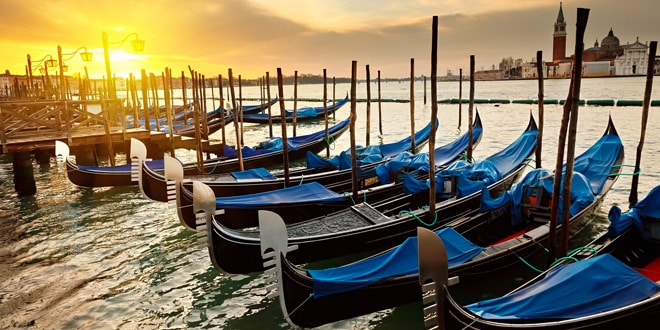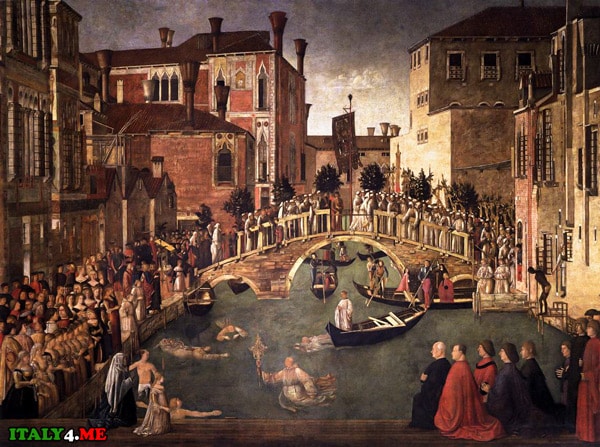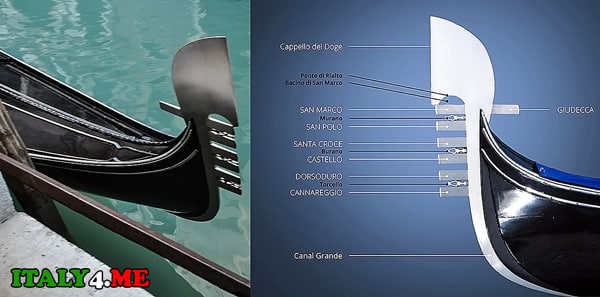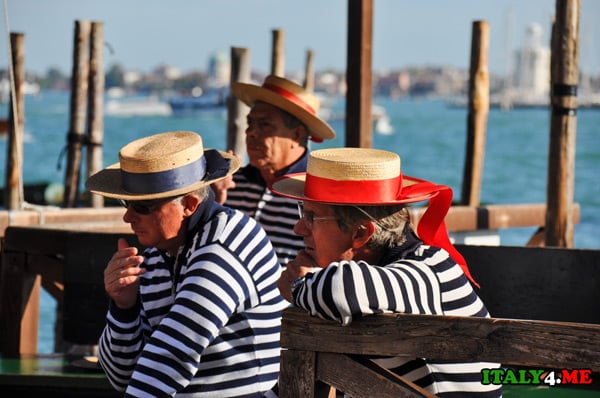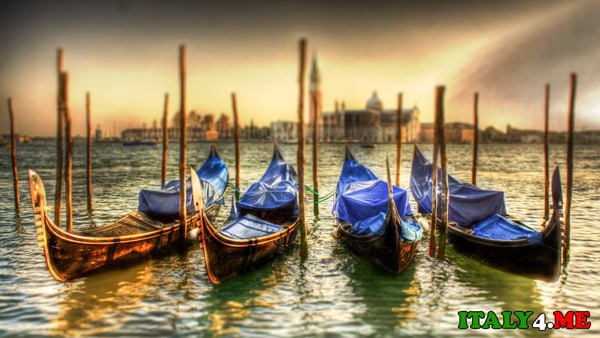Some dream of experiencing the city’s exquisite architecture on the water, and some aspire to tie their nuptial knots here. In contrast, others venture to Venice to plunge into its culture, seeking to learn as much as possible about its traditions and peculiarities.
Aside from its remarkable architecture and stunningly beautiful landscapes, Venice is famously situated on islands in a mesmerizing and picturesque lagoon, surrounded by water from all sides. The Venetian gondolas, gliding over the lagoon’s waves, are often hailed as the most beautiful boats in the world and are considered a “signature feature” – one of the main attractions of Venice. Our discussion today centers around these iconic vessels.
Page Contents
Summary – What do you Need to Know Before Taking a Gondola Ride in Venice
History
Over many centuries, the appearance of Venice’s popular river transport has changed several times. The current gondola results from a long process of “boat evolution” and adaptation to the needs of the city’s residents and the variable water quality. The city’s history and these vessels’ history are closely intertwined.
The first mentions of the gondola date back to 1094 when the Doge of Venice, Vitale Falier (Vitale Falier), granted some city residents the charter to build gondolas. Although the sources documenting the appearance of Venetian vessels are quite old, they fully describe how these unique boats looked in ancient times.
Interestingly, they were quite different from modern gondolas, painted in various colors. However, after 1562, the hull color became black, which remains the same today.
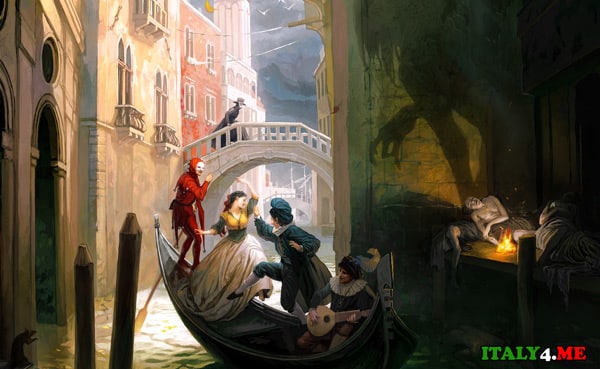
At the end of the 1400s, gondolas closely resembled other types of water transport used in the Venetian Lagoon at the time. Only in the early 1500s did the appearance of these boats begin to change, mainly because they were used for transporting local poor people. By the end of the 1600s, gondolas had almost taken the form we see today.
In the 1800s, technical innovations were added to their hulls, such as an asymmetric design, which allows gondoliers to easily control the vessel and skillfully maneuver between other boats.
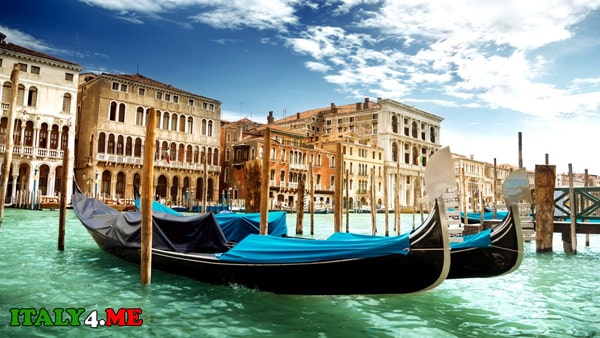
A few decades ago, gondolas were equipped with wooden cabins called “felze,” attached to the hull’s center. This construction was erected on boats in lousy weather to shelter passengers from the rain, but it was soon deemed unnecessary: the cabin obstructed the gondoliers’ view.
Today, gondolas are used exclusively by tourists. According to some estimates, about fifty gondolas currently cut through the waves of the magnificent Venetian Lagoon, which is half as many as in 1580.
Symbols and Details
Every detail of a gondola symbolizes something. Medieval decorators gave special significance to forged and metal parts, combining elegance and practicality.
For example, the iron bow of the vessel, ‘ferro da prora,’ usually in an S-shape reminiscent of the curves of the Grand Canal (Canal Grande), was designed to allow the gondolier to use his weight for balancing the boat. Additionally, the gondolas are equipped with a counterweight standard with six teeth, symbolizing the six districts of Venice.
Gondoliers
Tourists visiting Venice might mistakenly assume that all gondolas are similar or identical. However, this is not the case. In reality, these amazing “black swans” are made according to certain parameters officially approved by the city authorities, and everything else is crafted specifically for each rower.
Gondoliers always work on their own boats, which is quite expensive, ranging from 25 to 75 thousand euros. The unique profession of a gondolier is passed down from generation to generation.
Blood ties aren’t enough to ferry tourists in a beautiful boat. To obtain a special license, one must undergo a 9-month training course for gondoliers and then pass a serious and difficult exam.
Moreover, candidates for operating gondolas are also required to prove their proficiency in English. Only then will the city’s authorities consider the application for a license. It should be noted that gondolier is traditionally a male profession. However, there have been instances where women have taken the helm of Venice’s “swans.”
Also, read about the most beautiful palaces in Venice.
Interesting Facts About Gondolas
- Modern gondolas are both similar and dissimilar. As mentioned, the Venice City Hall has set standards for building these boats. Each weighs 700 kilograms (about 1,543 pounds) and consists of 280 parts carved from eight different types of wood: oak, elm, lime, larch, fir, cherry, walnut, and mahogany.
- Several theories explain the black color of modern gondolas. One theory suggests that the city council issued a decree prohibiting boats from being painted black to end the intense rivalry among Venetian elites. Wealthy gondola owners previously tried to decorate their boats in various ways to demonstrate their affluence. Another theory holds that black represents the Venetians’ mourning for the thousands lost to a terrible plague.
- Famous writers and poets often compared Venice’s “black swans” to coffins. Some studies confirm that Venetians associate gondolas with death.
- The first female gondolier received her license in 2010. Giorgia Boscolo, a 24-year-old daughter of a 40-year-old veteran gondolier, followed in her father’s footsteps. A German woman, Alex Hai, also aspired to this unique profession but failed the boat handling exam.
- A Venetian company, Row Venice, offers tourists the chance to learn gondolier. A professional gondolier will teach the basics of the job over an hour and a half and help apply the theory in practice. You’ll be given a boat similar to a gondola for practice. Row Venice website: www.rowvenice.com
- Instead of riding in a gondola, tourists can also visit the Squero San Trovaso boatyard, where new boats are built and old ones are serviced. Making one gondola takes about 500 hours, so Venice gains only about 20 “black swans” more each year.
- If you wish to see gondolas in all their glory, visit Venice on the first Saturday of September. On this day, a parade of decorated gondolas and their rowers occurs in the Grand Canal. Additionally, the historical regatta “Regata Storica” (Regata Storica) and a competition among Venetian boats are held.
How Much Does a Gondola Ride Cost?
Visiting Venice almost always includes a must-do activity: “riding a gondola.” It’s no surprise, as the city reveals itself from a different perspective when you glide along the waves of the Venetian Lagoon. What could be more romantic in Venice than an evening gondola ride with your significant other? However, it’s important to note that gondolier services are not exactly cheap.
Gondoliers typically charge 80 euros for a 30-minute ride, but this cost is for renting the entire boat.
For instance, if you’re traveling with four friends, the ride would cost each person 20 euros. Remember, though, that the number of seats in a gondola is always limited. Moreover, the cost of a ride increases in the evening (up to an additional 20 euros).
Official Prices & Timetables
DAYTIME HOURS (from 9.00 to 19.00): 80.00 euros
for a 30-minute tour
NIGHT TIME (from 7.00 pm to 3.00 am): 100.00 euros
for a 35-minute tour
 Italy for me From Italy with love
Italy for me From Italy with love

